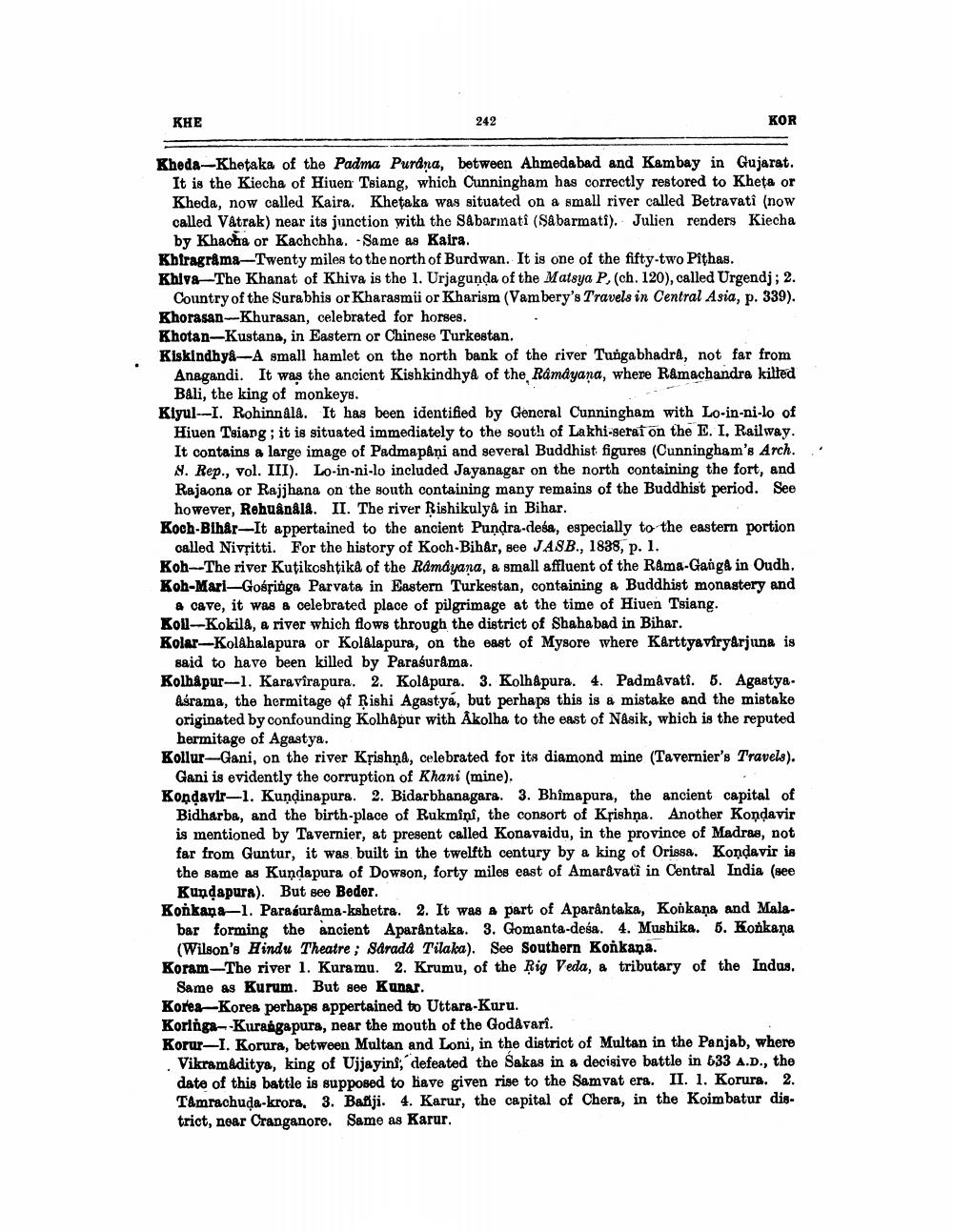________________
KHE
242
KOR
.
Kheda-Khetaka of the Padma Purana, between Ahmedabad and Kambay in Gujarat.
It is the Kiecha of Hiuen Tsiang, which Cunningham has correctly restored to Kheta or Kheda, now called Kaira. Khetaka was situated on a small river called Betravati (now called Vatrak) near its junction with the Sabarmati (Sabarmati). Julien renders Kiecha
by Khacha or Kachchha. -Same as Kaira. Khfragrama-Twenty miles to the north of Burdwan. It is one of the fifty-two Pithas. Khiya The Khanat of Khiva is the 1. Urjagunda of the Matsya P. (ch. 120), called Urgendj; 2.
Country of the Surabhis or Kharasmii or Kharism (Vam bery's Travels in Central Asia, p. 339). Khorasan-Khurasan, celebrated for horses. Khotan-Kustana, in Eastern or Chinese Turkestan. Kiskindhya-A small hamlet on the north bank of the river Tungabhadrâ, not far from
Anagandi. It was the ancient Kishkindhyâ of the Ramayana, where Ramachandra killed
Bali, the king of monkeys. Kiyul--I. Rohinnala. It has been identified by General Cunningham with Lo-in-ni-lo of
Hiuen Triang; it is situated immediately to the south of Lakhi-gerai on the E. I. Railway. It contains a large image of Padmapâni and several Buddhist figures (Cunningham's Arch. 8. Rep., vol. III). Lo-in-ni-lo included Jayanagar on the north containing the fort, and Rajaona or Rajjhana on the south containing many remains of the Buddhist period. See however, Rehuânåla. II. The river Rishikulyê in Bihar. Koch-Bihar-It appertained to the ancient Pundra-desa, especially to the eastern portion
called Nivritti. For the history of Koch-Bihår, see JASB., 1838, p. 1. Koh--The river Kutikoshţika of the Ramayana, a small affluent of the Rama-Gange in Oudh. Koh-Marl-Gospinga Parvata in Eastern Turkestan, containing a Buddhist monastery and
a cave, it was a celebrated place of pilgrimage at the time of Hiuen Tsiang. Koll-Kokila, a river which flows through the district of Shahabad in Bihar. Kolar-Kolahalapura or Kolalapura, on the east of Mysore where Karttyaviryarjuna is
said to have been killed by Parasurama. Kolhapur--1. Karavirapura. 2. Kolapura. 3. Kolh&pura. 4. Padmavati. 6. Agastya
Asrama, the hermitage of Rishi Agastya, but perhaps this is a mistake and the mistake originated by confounding Kolhapur with Akolha to the east of Nasik, which is the reputed
hermitage of Agastya. Kollur-Gani, on the river Krishna, celebrated for its diamond mine (Tavernier's Travels).
Gani is evidently the corruption of Khani (mine). Kondavir-1. Kundinapura. 2. Bidarbhanagara. 3. Bhimapura, the ancient capital of
Bidharba, and the birth-place of Rukmini, the consort of Krishna. Another Kondavir is mentioned by Tavernier, at present called Konavaidu, in the province of Madras, not far from Guntur, it was built in the twelfth century by a king of Orissa. Kondavir is the same as Kundapura of Dowson, forty miles east of Amaravati in Central India (see
Kundapura). But see Beder. Konkana-1. Parasurama-kshetra. 2. It was a part of Aparantaka, Konkana and Mala
bar forming the ancient Aparantaka. 3. Gomanta-desa. 4. Mushika. 6. Konkana
(Wilson's Hindu Theatre ; Sarada Tilaka). See Southern Konkana. Koram-The river 1. Kuramu. 2. Krumu, of the Rig Veda, a tributary of the Indus.
Same as Kurum. But see Kunar. Korea Kores perhaps appertained to Uttara-Kuru. Korloge-Kurangapura, near the mouth of the Godavari. Korur-I. Korura, between Multan and Loni, in the district of Multan in the Panjab, where . Vikramaditya, king of Ujjayini, defeated the Sakas in a decisive battle in 633 A.D., the
date of this battle is supposed to have given rise to the Samvat era. II. 1. Korura. 2. Tamrachuda-krora. 3. Bafiji. 4. Karur, the capital of Chera, in the Koimbatur district, near Cranganore. Same as Karur.




